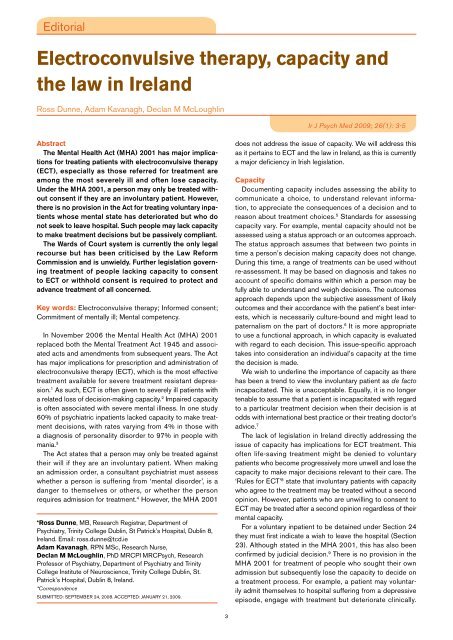View - TARA - Trinity College Dublin
View - TARA - Trinity College Dublin
View - TARA - Trinity College Dublin
Create successful ePaper yourself
Turn your PDF publications into a flip-book with our unique Google optimized e-Paper software.
Editorial<br />
Electroconvulsive therapy, capacity and<br />
the law in Ireland<br />
Ross Dunne, Adam Kavanagh, Declan M McLoughlin<br />
Ir J Psych Med 2009; 26(1): 3-5<br />
Abstract<br />
The Mental Health Act (MHA) 2001 has major implications<br />
for treating patients with electroconvulsive therapy<br />
(ECT), especially as those referred for treatment are<br />
among the most severely ill and often lose capacity.<br />
Under the MHA 2001, a person may only be treated without<br />
consent if they are an involuntary patient. However,<br />
there is no provision in the Act for treating voluntary inpatients<br />
whose mental state has deteriorated but who do<br />
not seek to leave hospital. Such people may lack capacity<br />
to make treatment decisions but be passively compliant.<br />
The Wards of Court system is currently the only legal<br />
recourse but has been criticised by the Law Reform<br />
Commission and is unwieldy. Further legislation governing<br />
treatment of people lacking capacity to consent<br />
to ECT or withhold consent is required to protect and<br />
advance treatment of all concerned.<br />
Key words: Electroconvulsive therapy; Informed consent;<br />
Commitment of mentally ill; Mental competency.<br />
In November 2006 the Mental Health Act (MHA) 2001<br />
replaced both the Mental Treatment Act 1945 and associated<br />
acts and amendments from subsequent years. The Act<br />
has major implications for prescription and administration of<br />
electroconvulsive therapy (ECT), which is the most effective<br />
treatment available for severe treatment resistant depression.<br />
1 As such, ECT is often given to severely ill patients with<br />
a related loss of decision-making capacity. 2 Impaired capacity<br />
is often associated with severe mental illness. In one study<br />
60% of psychiatric inpatients lacked capacity to make treatment<br />
decisions, with rates varying from 4% in those with<br />
a diagnosis of personality disorder to 97% in people with<br />
mania. 3<br />
The Act states that a person may only be treated against<br />
their will if they are an involuntary patient. When making<br />
an admission order, a consultant psychiatrist must assess<br />
whether a person is suffering from ‘mental disorder’, is a<br />
danger to themselves or others, or whether the person<br />
requires admission for treatment. 4 However, the MHA 2001<br />
*Ross Dunne, MB, Research Registrar, Department of<br />
Psychiatry, <strong>Trinity</strong> <strong>College</strong> <strong>Dublin</strong>, St Patrick’s Hospital, <strong>Dublin</strong> 8,<br />
Ireland. Email: ross.dunne@tcd.ie<br />
Adam Kavanagh, RPN MSc, Research Nurse,<br />
Declan M McLoughlin, PhD MRCPI MRCPsych, Research<br />
Professor of Psychiatry, Department of Psychiatry and <strong>Trinity</strong><br />
<strong>College</strong> Institute of Neuroscience, <strong>Trinity</strong> <strong>College</strong> <strong>Dublin</strong>, St.<br />
Patrick’s Hospital, <strong>Dublin</strong> 8, Ireland.<br />
*Correspondence<br />
submitted: september 24, 2008. accepted: january 21, 2009.<br />
does not address the issue of capacity. We will address this<br />
as it pertains to ECT and the law in Ireland, as this is currently<br />
a major deficiency in Irish legislation.<br />
Capacity<br />
Documenting capacity includes assessing the ability to<br />
communicate a choice, to understand relevant information,<br />
to appreciate the consequences of a decision and to<br />
reason about treatment choices. 5 Standards for assessing<br />
capacity vary. For example, mental capacity should not be<br />
assessed using a status approach or an outcomes approach.<br />
The status approach assumes that between two points in<br />
time a person’s decision making capacity does not change.<br />
During this time, a range of treatments can be used without<br />
re-assessment. It may be based on diagnosis and takes no<br />
account of specific domains within which a person may be<br />
fully able to understand and weigh decisions. The outcomes<br />
approach depends upon the subjective assessment of likely<br />
outcomes and their accordance with the patient’s best interests,<br />
which is necessarily culture-bound and might lead to<br />
paternalism on the part of doctors. 6 It is more appropriate<br />
to use a functional approach, in which capacity is evaluated<br />
with regard to each decision. This issue-specific approach<br />
takes into consideration an individual’s capacity at the time<br />
the decision is made.<br />
We wish to underline the importance of capacity as there<br />
has been a trend to view the involuntary patient as de facto<br />
incapacitated. This is unacceptable. Equally, it is no longer<br />
tenable to assume that a patient is incapacitated with regard<br />
to a particular treatment decision when their decision is at<br />
odds with international best practice or their treating doctor’s<br />
advice. 7<br />
The lack of legislation in Ireland directly addressing the<br />
issue of capacity has implications for ECT treatment. This<br />
often life-saving treatment might be denied to voluntary<br />
patients who become progressively more unwell and lose the<br />
capacity to make major decisions relevant to their care. The<br />
‘Rules for ECT’ 8 state that involuntary patients with capacity<br />
who agree to the treatment may be treated without a second<br />
opinion. However, patients who are unwilling to consent to<br />
ECT may be treated after a second opinion regardless of their<br />
mental capacity.<br />
For a voluntary inpatient to be detained under Section 24<br />
they must first indicate a wish to leave the hospital (Section<br />
23). Although stated in the MHA 2001, this has also been<br />
confirmed by judicial decision. 9 There is no provision in the<br />
MHA 2001 for treatment of people who sought their own<br />
admission but subsequently lose the capacity to decide on<br />
a treatment process. For example, a patient may voluntarily<br />
admit themselves to hospital suffering from a depressive<br />
episode, engage with treatment but deteriorate clinically.<br />
3
Ir J Psych Med 2009; 26(1): 3-5<br />
Figure 1: Current pathways to ECT treatment<br />
Codes of Practice governing the use of ECT<br />
for Voluntary Patients<br />
Section 59 of the Mental Health Act 2001<br />
Voluntary admission<br />
Indicates wish to<br />
leave hospital<br />
Involuntary Sections<br />
23 & 24<br />
Involuntary<br />
Admission<br />
Need for ECT<br />
Need for ECT<br />
No Capacity<br />
No capacity<br />
Capacity<br />
Capacity<br />
Voluntary ECT<br />
Does not indicate<br />
wish to leave<br />
hospital<br />
?<br />
2nd Opinion<br />
Form 16<br />
Involuntary ECT<br />
No consent<br />
Informed Consent<br />
Voluntary ECT<br />
Such a patient might become stuporose but be passively<br />
compliant with medication. The patient might benefit from<br />
ECT, but there is currently no way to treat them within the<br />
law. One possibility is to discharge and re-admit patients. We<br />
find this to be neither in the spirit of the Act nor in the best<br />
interests of the patient. It would constitute an ‘involuntary<br />
discharge’ in a patient incapable of consenting to discharge.<br />
This violates the treatment contract. Another possibility is to<br />
subvert the Act by having an application made to admit the<br />
person involuntarily as if they were an outpatient, even though<br />
they are voluntary inpatients. This solution is legally precarious<br />
at best. The Mental Health Commission (MHC) does not<br />
support such practice.<br />
The MHC acknowledges that the Act makes no provision<br />
for the assessment of capacity, although the ‘Rules for<br />
ECT’ do outline the assessment of capacity and informed<br />
consent. 10,11 The most recent ‘Code of practice governing<br />
the use of ECT for voluntary patients (2008)’ is also silent<br />
on this issue. 12<br />
The current pathways to ECT treatment are outlined in<br />
Figure 1, which illustrates that clarification is needed with<br />
regard to voluntary, but incapacitated, patients and also for<br />
detained patients with capacity to refuse ECT. We must<br />
have legal procedures that safeguard patients’ best interests<br />
and provide for common eventualities without the need for<br />
the traditional ‘Irish solution to an Irish problem’ approach.<br />
A system is required where best medical practice and best<br />
legal practice are not mutually exclusive.<br />
The Mental Capacity and Guardianship Bill 2007<br />
The Law Reform Commission (LRC) published the consultation<br />
paper Mental Capacity and Vulnerable Adults in 2005<br />
coinciding with the enactment of the Mental Capacity Act in<br />
the United Kingdom. 13 This was followed in 2006 by publication<br />
of their final report 14 with proposals similar to those<br />
currently in force in the UK. The assessment of capacity is<br />
deemed to be a distinct issue, and one which applies to a far<br />
greater variety of situations than those envisaged in the MHA<br />
2001, including the capacity of patients to consent to surgical<br />
procedures, testamentary capacity and enduring power<br />
of attorney.<br />
The LRC recommendations culminated in the Mental<br />
Capacity and Guardianship Bill 2007, which passed through<br />
the second stage in the Seanad in February 2007 and has<br />
now been passed to the committee stage. 15 The Bill replaces<br />
the Wards of Court system with a Guardianship system,<br />
whereby a voluntary but incapacitated patient would have<br />
a public guardian appointed to make healthcare decisions<br />
for them. The Bill states that the known views of the patient<br />
and the wishes of their family should be taken into account;<br />
however, it is not clear whether family members can make<br />
decisions on behalf of a relative. It is notable that ECT is not<br />
explicitly mentioned in the Bill but this legislation would form<br />
the pathway to care for incapacitated passively compliant<br />
patients when ECT is indicated.<br />
It is unclear how the proposed guardianship legislation<br />
will work in practice and how it will change the treatment of<br />
4
Ir J Psych Med 2009; 26(1): 3-5<br />
voluntary but incapacitated patients who would benefit from<br />
ECT. It is conceivable that these patients would have a public<br />
guardian appointed before treatment with ECT. However,<br />
the Bill states that some decisions can be taken in the best<br />
interests of the patient where they lack capacity. For example,<br />
pending a decision from a guardianship board, the treating<br />
team is bound to prevent deterioration in the patient’s<br />
condition.<br />
The Bill also states that a Public Guardian may not refuse<br />
consent to the “carrying out or continuation of life-sustaining<br />
treatment”. What constitutes life-sustaining treatment is not<br />
made explicit, but Section 27 of the Bill instructs the Office of<br />
the Public Guardian to construct codes of practice concerning<br />
the implementation of the Act.<br />
Capacity is defined in the Bill as “the ability to understand<br />
the nature and consequences of a decision in the context of<br />
available choices at the time the decision is to be made”. As<br />
no test for capacity is mentioned in the current stage of the<br />
Bill, it will be incumbent on the Office of the Public Guardian<br />
to clarify this. We fear that leaving the actual implementation<br />
of the Act to evolution, rather than appropriate planning<br />
and consultation, will result in the same problems currently<br />
encountered with the Mental Health Act 2001.<br />
Banning involuntary ECT<br />
In June 2008, a Private Member’s Bill was debated in the<br />
Seanad. 17 This Bill proposed to amend the MHA 2001 to<br />
remove Section 58 and amend Section 59, thus prohibiting<br />
the prescription of ECT for involuntary inpatients who do not<br />
consent.<br />
Essentially, informed consent would be necessary for<br />
the prescription of ECT for involuntary patients. The aim of<br />
this proposal is to promote the use of advance directives<br />
made by patients early in the course of their illness when<br />
they have capacity. The assumption is that advance directives<br />
will prevent paternalism and promote the rights of the<br />
patient. However, no pathway to treatment is proposed for<br />
those patients who enter hospital as incapacitated patients,<br />
no alternatives are proposed in the absence of an advance<br />
directive and these are not currently recognised in Irish law. In<br />
contrast, the scientific evidence brought to the debate by the<br />
Minister for State highlighted that the state has a duty of care<br />
to involuntary patients which would be potentially undermined<br />
by a ban on involuntary ECT.<br />
A ban on involuntary ECT would render us unable to treat<br />
some of the most mentally ill patients in society. It would lead<br />
to medical deterioration and subsequent general hospital<br />
treatment for some. It would mean a basic violation of the<br />
treatment contract, because our detention in hospital of involuntary<br />
patients should be based on the principle of reciprocity<br />
under which we must aim to restore decision-making capacity<br />
to incapacitated patients.<br />
Inevitably, this situation has come about because of the<br />
public perception of ECT as a high-risk, low-benefit procedure;<br />
meaning that a very high threshold is set for incapacity<br />
with regard to its use. In fact ECT is one of the most effective<br />
and safe treatments in medicine. 1<br />
Currently, every medical practitioner is in a legal vacuum<br />
when caring for voluntary inpatients requiring treatment with<br />
ECT but lacking capacity. (Indeed, this applies to other treatments<br />
as well). The Mental Health Act 2001 has significantly<br />
improved the treatment process available to people suffering<br />
mental ill health in Ireland in that the addition of tribunals<br />
and the checks and balances on involuntary admission aim to<br />
protect patients’ rights and interests. The proposed Mental<br />
Capacity and Guardianship Bill will secure the presumption<br />
of capacity in Irish law. However, it remains to be seen how<br />
the yet to be developed ‘codes of practice’ will impact upon<br />
the treatment of voluntary but incapacitated patients with<br />
ECT.<br />
Acknowledgements<br />
Our work is supported by the Health Research Board and<br />
the Friends of St Patrick’s Hospital.<br />
Declarations of interest: None.<br />
References<br />
1. UK ECT Review Group. Efficacy and safety of electroconvulsive therapy in depressive<br />
disorders: a systematic review and meta-analysis. Lancet 2003 Mar 8; 361(9360):<br />
799-808.<br />
2. Hotopf M, Laird B, Singh I et al. Capacity, consent and electroconvulsive therapy: A<br />
qualitative and cross-sectional study. J Mental Health 2008; 17(3): 315-325.<br />
3. Owen GS, Richardson G, David AS, Szmukler G, Hayward P, Hotopf M. Mental<br />
capacity to make decisions on treatment in people admitted to psychiatric hospitals:<br />
cross sectional study. BMJ 2008; 337: a448.<br />
4. Oireachtas na hÉireann, Mental Health Act, 2001, Part 1, Section 3, Subsection 1,<br />
(a) & (b). www.irishstatutebook.ie/2001/en/act/pub/0025/index.html<br />
5. Appelbaum PS. Assessment of patients’ competence to consent to treatment. New<br />
Eng J Med 2007 Nov 1; 357(18): 1834-40.<br />
6. Law Reform Commission, Report – Vulnerable Adults and the Law, (83-2006)<br />
December 2006. Section 1.63. www.lawreform.ie/Vulnerable%20Adults%20<br />
Report%20Final%20Dec%202006.pdf<br />
7. Grisso T, Applebaum PS. Assessing competence to consent to treatment – A guide<br />
for physicians and other health professionals. Oxford University Press: New York,<br />
1998.<br />
8. Mental Health Commission, Rules Governing the Use of Electro-Convulsive Therapy<br />
Reference Number: R-S59(2)/01/2006 www.mhcirl.ie/act/Rules%20for%20the%20<br />
use%20of%20%20Electroconvulsive%20Therapy%20MHA%202001%20S59(2).pdf<br />
9. Decision of Mr Justice Higgins, 21st December 2006: Q vs. St. Patrick’s Hospital<br />
(respondent) and MHT, MHC (Notice Parties).<br />
10. Communication from Mental Health Commission to Dr Ross Dunne specifically<br />
regarding this issue.<br />
11. Oireachtas na hÉireann, Mental Health Act, 2001, Part 4, Section 56, (a) & (b).<br />
12. Mental Health Commission, Code of Practice Governing the Use of Electro-<br />
Convulsive Therapy for voluntary patients. Reference Number: COP-S33/02/2008<br />
www.mhcirl.ie/act/COP%20-%20S33-02-2008%20Use%20of%20ECT%20for%20<br />
Voluntary% 20Patients.pdf<br />
13. United Kingdom, Parliament. Mental Capacity Act 2005. www.dca.gov.uk/menincap/<br />
legis.htm<br />
14. Law Reform Commission, Report – Vulnerable Adults and the Law, (83-2006)<br />
December 2006.<br />
15. Seanad Éireann, Mental Capacity and Guardianship Bill 2007. www.oireachtas.ie/<br />
documents/bills28/bills/2007/1207/b1207s.pdf<br />
16. Ibid. Section 27, (1), (d).<br />
17. Seanad Éireann, Mental Health (Involuntary Procedures) (Amendment) Bill 2008.<br />
http://www.oireachtas.ie/documents/bills28/bills/2008/3608/b3608s.pdf<br />
Cover series 2009<br />
This year we continue our cover series of artwork from the artists involved in the art therapy group at the Central Mental<br />
Hospital, Dundrum, Co <strong>Dublin</strong>, Ireland. Art, as a therapeutic activity for patients, began in the 1970s at the hospital<br />
and became part of the vocational education programme there in 1985. Patients’ work has been exhibited in a number<br />
of initiatives including the Lundbeck Art Initiative and in various venues throughout the country including<br />
Cork, Kilkenny, <strong>Dublin</strong> and Wicklow.<br />
5
















